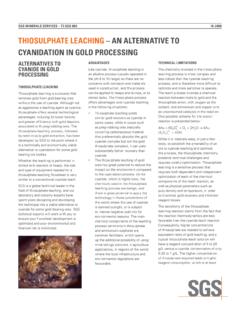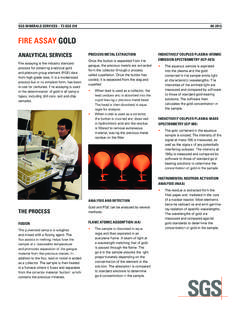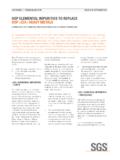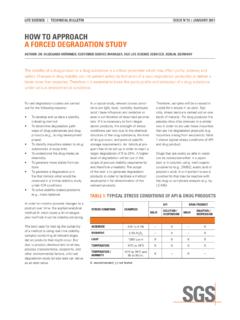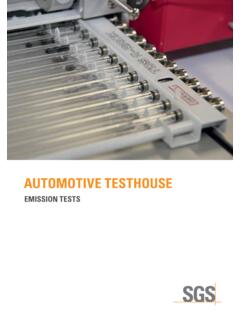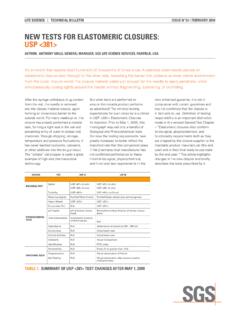Transcription of Asset Integrity Management - SGS
1 Integrity MAnAGeMentPArtnerInG tO AChIeve yOur InSPeCtIOn, enGIneerInG, dAtA Management And SAfety GOAlSASSet Integrity Management AIMAn Asset has Integrity when it is operated and maintained so that the combination of the likelihood of failure and the consequence of failure makes the risk to people, to the environment, and to the company as low as reasonably Integrity , safety, and reliability are major concerns to all plant operators and managers. The primary objective of Asset Integrity Management (AIM) is to maintain the Asset in a fit-for-service condition while extending its remaining life in the most reliable, safe, and cost-effective manner. In addition to regulatory and company requirements, operators of facilities and pipelines have the following business needsn Maximizing production n Reducing lost income due to unplanned shutdowns n Optimizing inspection and maintenance costs n Maximizing Asset value n Maintaining an auditable systemMost of our clients already have some form of Asset Integrity Management program in place.
2 However, with increased regulatory oversight, increased operating costs, and limited available resources, implementation of a fully compliant program is increasingly challenging for most organizations. SGS is able to effectively partner with our clients to help them overcome these AIM experts provide customized solutions at any level of the development and implementation develOPMentSGS has extensive experience in developing and documenting risk-based, time-based, and condition-based inspection programs for regions all over the world. Our programs meet API-580, API-581, PAS 55 and other appropriate requirements as MAnAGeMentSGS has experienced project managers and engineers who can oversee all aspects of the project. Our personnel are also able to handle the Management of change process necessary to transition from time-based or condition-based to risk-based inspection tO IMPleMent the PrOGrAMSGS can participate in implementation at any level, from turn-key program development and implementation to simple gap-filling services.
3 Our inspectors are full-time employees trained in our safety and quality methodologies. We provide a full range of NDT services including advanced inspection experts provide a comprehensive scope of fitness-for-service assessments including determination of damage mechanisms. We can offer stand-alone CAD drawing packages to support client-based or third-party inspection programs and provide a unique set of value adding methodologies including data Management services, electronic document Management , and field inspection data collection GAP AnAlySISSGS experts assist our clients in identifying the gaps between their program needs and current understands the importance of insuring the availability of the real time Key Performance Indicators (KPI) that are critical to successful APPrOACh tO AIMV erification/Certification of n Emergency Escape and Rescue System n Emergency Shutdown System n Fire and Gas Detection System n Fire and Lightning Protection n Security Systemn Design Verification/ Certification n Regulatory Compliance n Risk Assessment (Hazop)
4 N Fitness for Service (FFS) Assessment n Material Properties n Finite Element Analysisn Mechanical Integrity Management n Pipeline Integrity Management n Remaining Life Calculations n Data Gathering and Field Inspectionsn Risk Based Inspection n Regulatory Compliance n Inspection and Maintenance Planning n Non-Destructive and Material Testingn Document Management and Control n Pas 55 Asset Management System CertificationdeSIGnSAfeGuArdInG SySteMSMAI ntenAnCe & InSPeCtIOnSGS has implemented hundreds of Asset Integrity Management programs worldwide, including nearly two hundred Risk-Based Inspection (RBI) programs. We have found that although there are similarities among all of the programs, no two programs are identical. We put our breadth of knowledge, born from our extensive experience, to work for each of our clients to provide customized solutions for their unique needs.
5 Successfully implementing an AIM system requires the right combination of design, engineering, and operational Integrity . SGS partners with our clients to provide exactly the level of services they need. These services can range from complete turn-key program design and implementation to simple gap-filling to complement a clients existing AIM program. The diagram below shows the scope of services which SGS provides its has been a leader in development and implementation of comprehensive programs to comply with OSHA s Process Safety Management standards since their introduction in 1992. SGS engineering staff at our Asset Integrity Management Competence Center are entirely focused on mechanical Integrity services. SGS engineers ensure that Recognized and Generally Accepted Good Engineering Practices (RAGAGEP) are followed and provide assistance, inspection, and evaluation based on recognized standardsn ASME Boiler & Vessel Codes (Sec VIII Div I & II) n ASME Piping Codes ( , , , ) n Pressure Vessel Inspection (API 510) n Pressure Piping Inspection (API 570) n Pressure Relief Systems (API 520/526) n Tank Evaluations (API 620/650/653) n Risk-Based Inspection (API 580/581) n Fitness for Service (API 579) n Damage Mechanisms (API 571)
6 The Competence Center for Asset Integrity Management s engineering team specialize in a variety of disciplines and offer a complete range of engineering services, including the followingdeSIGn ServIC eS And COMPO nent AnAlySISThe SGS AIM team has a vast experience in new equipment design, pressure vessel component analysis and pipe stress engineers performing the analysis have extensive knowledge and experience in ASME and international standards, with capabilities such asn Perform new equipment design and pressure vessel component analysis using popular software as per clients needs n Analyzing pressure relieving systems n Perform intense analysis as per Div II and include stress maps for the different components of the equipment using finite element analysis n Customized engineering analysisfItneSS fOr ServIC e ASSeSSMentS SGS AIM Engineering provides customized and cost effective assessments for the FFS issues and challenges that are common in refining, upgrading, chemical, paper & pulp, and gas processing facilities.
7 Over the last five years SGS has conducted over 12,000 assessments of pressure vessels, piping, and storage tanks in accordance with API 579-1/ ASME FFS-1. Key features of our FFS assessments includen The ability to utilize advanced techniques such as finite element analysis to assess equipment n Industry leading turnaround for the FFS assessments meaning reduced shutdown time, and more effective remediation n Extensive practical experience which allows SGS to recommend practical solutions to difficult FFS problems n Identification of alternate service options which could allow operation with enhanced equipment performance n Recommendation of effective remediation and repair approachesrISK ServICeSSGS Reliability and Risk Management Program (RRMP) can be linked with existing inspection programs both locally and globally.
8 The program provides improved effectiveness of existing programs throughn Providing emphasis on lean inspection strategies, safety compliance, failure prevention and focus on critical components n Damage mechanism review and assessment n Identify the existing risk category and provide cost effective measures through inspection program to reduce and contain the risk n Review and compile historical inspection data in preparation for or in support of RBI implementation n Assist in acquisition of Owner/User commissionsfIXed eQuIPMent deGrAdAtIOn MeChAnISM ServICeSSGS AIM engineering department includes engineers with experience evaluating damage mechanisms for equipment including pressure vessels, pressure piping, storage tanks, heat exchangers, heaters, and specialized equipment. This includes on-stream assessment as well as investigation of root causes of major industrial accidents.
9 SGS AIM can provide support services for identification of fixed equipment degradation mechanisms n Identifying degradation devices effecting the reliability of fixed equipment n Recommending acceptable criteria for degradation devices to become effective n Recommending lean inspection strategies, inspection plans and critical inspection locations n Identifying internal as well as external corrosion rangesenGIneerInG ServICeSAPI-579 ffS evAluAtIOnSfIeld InSPeCtIOn ServICeStOOlS & ServICeSAPI 580 rBI ServICeSASMe SeC vIII dIv I & II deSIGn ServICeSfInIte eleMent & StreSS AnAlySISAPI-571 dAMAGe MeChAnISMSAPI 650, API 653 & API 620n Defining effect of high temperature and erosion n Preparing detailed reports describing type of degradation mechanisms, effect of degradation mechanisms, process streams, mass balance etc.
10 N Identifying active and accurate degradation mechanisms for implementation in risk-based inspection and fitness for service n Provide customized reports to show the balance of cost and effectiveness for the degradation mechanisms under reviewfI nIte eleMent AnAlySIS (feA)SGS offers the complete range of FFS assessments from initial assessment through Level III (Finite Element) analysis, as well consulting for cause and effect analysis. Using the most current technology, SGS engineering experts have the ability to utilize advanced techniques such as finite element analysis to assess equipment. Our industry leading FFS assessments mean reduced shutdown time, and more effective remediation. ASSeSSMent And AnAlySIS Key features of FEAn Develop 2D and 3D models of pressure vessel and piping systems n Analyze external loads on nozzles n Evaluate load cases that contribute to failure in piping and pressure vessel components n Analysis capabilities: Linear, material non-linear, steady state transient thermal, stress stiffening n The nozzle evaluation reports include.

